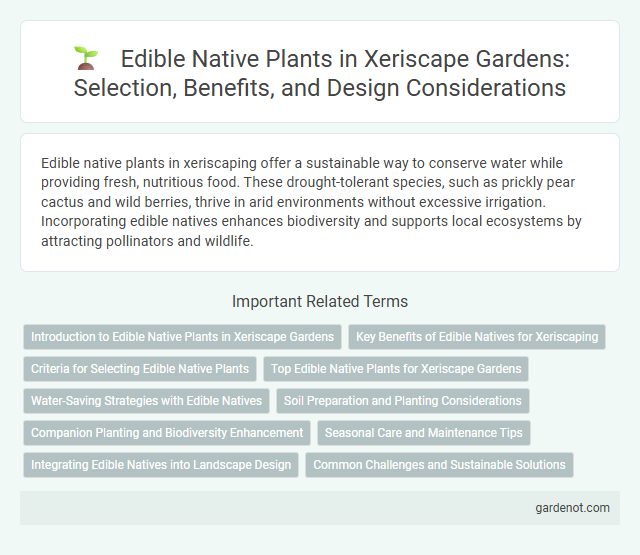Edible native plants in xeriscaping offer a sustainable way to conserve water while providing fresh, nutritious food. These drought-tolerant species, such as prickly pear cactus and wild berries, thrive in arid environments without excessive irrigation. Incorporating edible natives enhances biodiversity and supports local ecosystems by attracting pollinators and wildlife.
Introduction to Edible Native Plants in Xeriscape Gardens
Edible native plants in xeriscape gardens offer drought-tolerant, resource-efficient options that thrive with minimal water and maintenance, enhancing sustainability. Common species include wild blueberries (Vaccinium angustifolium), prickly pear cactus (Opuntia spp.), and elderberries (Sambucus canadensis), each providing nutritious fruits while supporting local ecosystems. Incorporating these plants into xeriscaping promotes biodiversity, conserves water, and delivers fresh, organic harvests year-round.
Key Benefits of Edible Natives for Xeriscaping
Edible native plants enhance xeriscaping by conserving water through deep root systems adapted to arid climates, reducing irrigation needs significantly. These plants support local ecosystems by providing natural food sources for pollinators and wildlife, promoting biodiversity in water-restricted landscapes. Additionally, edible natives offer nutritious, low-maintenance harvests, combining sustainability with functional landscaping benefits.
Criteria for Selecting Edible Native Plants
Selecting edible native plants for xeriscaping requires consideration of drought tolerance, soil adaptability, and nutritional value to ensure sustainability and health benefits. Preference should be given to species with proven resilience in arid climates, such as prickly pear cactus, mesquite, and wild berries, which thrive with minimal water input. Additionally, understanding local ecosystems and potential for pest resistance enhances long-term plant viability and edible yield in water-efficient landscapes.
Top Edible Native Plants for Xeriscape Gardens
Top edible native plants for xeriscape gardens include prickly pear cactus, which produces nutritious pads and fruits rich in vitamins, and wild blueberries, known for their drought tolerance and antioxidant-packed berries. Manzanita offers edible berries with a tart flavor while requiring minimal water, making it ideal for xeriscape settings. Other valuable options are elderberries and serviceberries, both providing flavorful fruits and thriving in low-water environments, thereby enhancing sustainability and biodiversity in xeriscape landscapes.
Water-Saving Strategies with Edible Natives
Water-saving strategies with edible native plants emphasize drought-tolerant species like nopales, mesquite, and amaranth, which thrive with minimal irrigation. Incorporating these natives into xeriscape gardens reduces water consumption by up to 50%, supports local ecosystems, and provides sustainable food sources. Utilizing mulch and deep-root watering further enhances moisture retention and plant resilience in arid environments.
Soil Preparation and Planting Considerations
Edible native plants thrive in well-drained, nutrient-rich soil prepared by incorporating organic matter such as compost or aged manure to enhance soil fertility and structure. Selecting plants suited to local climate and soil types ensures optimal growth, with spacing adjusted to accommodate mature plant size and sunlight requirements. Mulching around plants conserves moisture, suppresses weeds, and maintains consistent soil temperature critical for healthy root development in xeriscape gardening.
Companion Planting and Biodiversity Enhancement
Edible native plants play a crucial role in xeriscaping by promoting companion planting strategies that improve soil health and pest resistance, optimizing water efficiency. Integrating these species supports biodiversity enhancement, attracting pollinators like bees and butterflies essential for ecosystem balance. Strategic placement of edible natives in xeriscape designs fosters resilient landscapes that conserve water while providing nutritious harvests.
Seasonal Care and Maintenance Tips
Edible native plants in xeriscaping require minimal seasonal care, thriving with occasional pruning and mulching to conserve soil moisture. Regular monitoring during dry seasons helps prevent pests and diseases without excess irrigation. Harvesting ripe fruits and leaves promotes healthy regrowth and maximizes yield throughout the growing season.
Integrating Edible Natives into Landscape Design
Integrating edible native plants into xeriscape landscape design enhances water efficiency while providing sustainable food sources and promoting local biodiversity. Species like prickly pear cactus, elderberry, and wild grape thrive in arid environments, requiring minimal irrigation and maintenance. These plants support pollinators and wildlife, creating an ecologically balanced garden that harmonizes utility with natural habitat preservation.
Common Challenges and Sustainable Solutions
Common challenges of incorporating edible native plants in xeriscape gardens include limited availability of certain species, soil nutrient deficiencies, and inconsistent water supply. Sustainable solutions involve selecting drought-tolerant, native edible varieties such as prickly pear cactus and mesquite, implementing rainwater harvesting systems, and enhancing soil health through organic mulches and compost. These practices reduce water usage while ensuring productive, resilient landscapes that support local ecosystems.
Edible native Infographic

 gardenot.com
gardenot.com